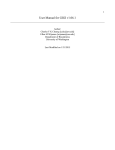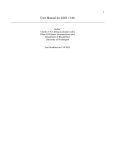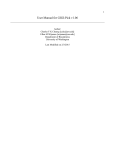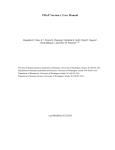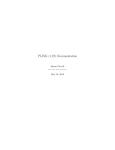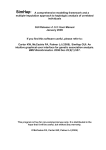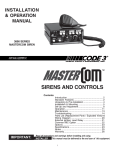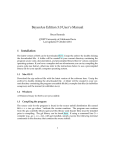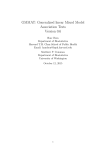Download User Manual for GIGI-Check v1.06
Transcript
1 User Manual for GIGI-Check v1.06 Author: Charles Y K Cheung [[email protected]] Ellen M Wijsman [[email protected]] Department of Biostatistics University of Washington Last Modified on 2/3/2015 2 Contents Introduction ................................................................................................................................................3 Citing GIGI-Check .....................................................................................................................................3 Software URL ............................................................................................................................................3 What’s new in version 1.06? ......................................................................................................................3 Files in GIGI-Check software distribution.................................................................................................4 Inferring IVs using gl_auto ........................................................................................................................4 Installing GIGI-Check................................................................................................................................4 Running GIGI-Check .................................................................................................................................4 Options .......................................................................................................................................................5 Making the Parameter File .........................................................................................................................6 File Formats ...............................................................................................................................................7 Output files ...............................................................................................................................................10 Frequently Asked Questions (FAQs) ....................................................................................................... 11 Appendix A ..............................................................................................................................................12 License .....................................................................................................................................................13 Acknowledgement ...................................................................................................................................13 3 Introduction GIGI-Check is a C++ program to detect Mendelian consistent genotyping errors of dense markers in pedigree data. It detects genotyping errors by using Inheritance Vectors (IVs), which are inferred by using sparse framework genotypes available on a subset of relatives in the pedigree. Thus, our error detection approach consists of two steps. The first step is to infer IVs at the positions of framework markers using gl_auto, a MCMC-based program from the MORGAN package. We assume that these markers are free of genotyping errors. The second step is to detect errors in dense genotypes by GIGICheck using the IVs and pedigree structure file from MORGAN. In this documentation, we use the following terminology. Framework markers are a relatively sparse set of markers used to infer IVs on a chromosome of interest. Dense markers are markers with missing genotypes on some subjects that we want to detect genotyping errors. For example, these dense markers may be genotypes obtained from sequence data or from a dense SNP panel, and may be typed on fewer and even different subjects in the pedigree. See the publication describing GIGI-Check, below, for more information. GIGI-Check is developed under the linux environment. Citing GIGI-Check Cheung, CYK., Thompson, E.A., Wijsman, E.M. (2014) Detection of Mendelian Consistent Genotyping Errors in Pedigrees. Genetic Epidemiology 38(4):291-299. Software URL http://faculty.washington.edu/wijsman/software.shtml What’s new in version 1.06? We have made changes so that GIGI is now compatible with the new Inheritance Vectors file format generated by MORGAN's gl_auto version 3.2! Because this new file format no longer requires users to provide GIGI with the meiosis indexes, GIGI can now directly use the MORGAN pedigree file. (In the past version that uses MORGAN’s gl_auto version 3.1 or earlier, users must create the pedigreemeiosis file from manually parsing the console output of gl_auto.) Therefore, to avoid confusion, we suggest our users to use the pedigree file instead of the pedigree meiosis file from now on. We also understand the importance of backward compatibility. You may continue to use gl_auto's output from the pre v3.2 and the pedigree meiosis file (in place of the pedigree file). GIGI will detect which kind of the file you are using and read it properly. 4 Files in GIGI-Check software distribution GIGI-Check software code and its dependency files - the Mersenne random number generator • example folder Inferring IVs using gl_auto The first step is to use framework markers to infer IVs. For this purpose, we use gl_auto, a program in the MORGAN package that is freely available at http://www.stat.washington.edu/thompson/Genepi/MORGAN/Morgan.shtml. To infer IVs in gl_auto, we need to supply the required files in MORGAN format: (1) Pedigree file (2) Marker file: this is a composite file that contains the map positions of framework markers (in centiMorgans assuming the Haldane map function), allele frequencies of framework markers , and genotype data of framework markers (3) Parameter file used to run gl_auto In the parameter file for gl_auto, please make sure to use the option: output meiosis indicators (instead of “output founder genome labels”). GIGI-Check uses the Framework IVs file produced by gl_auto, representing the IVs as meiosis indicators at the position of each Framework marker. Refer to the documentation of MORGAN for guidance on setting up these files and on running gl_auto. Example files used to infer IVs using gl_auto are included under the “example/gl_auto_example” directory. For versions of GIGI-Check before ver. 1.06 We need to obtain 2 files from running gl_auto: (a) Framework IVs file: see instructions above (b) Pedigree-meiosis file: see Appendix A Installing GIGI-Check Simply unzip the files, navigate to the code directory, and type make If make does not work, go to the GIGI-Check.cpp’s directory and install the program by g++ GIGI-Check.cpp -o GIGI-Check Running GIGI-Check GIGI-Check accepts a parameter file. To run GIGI-Check, type 5 ./GIGI-Check <parameter file> <options> To run the example file, go to the main GIGI-Check program directory, and type ./GIGI-Check example/param-v3_2.txt Options [The flags are case-sensitive.] Flag Purpose -seed=NUM to change the default seed. NUM should be a number between 1 and 999999 -prog=NUM to print the progress of imputation at every NUM markers -outD= to specify the absolute directory path of where the output files will be created. If this flag is missing, the output files will be saved to the user’s current directory. e.g. /home/charles/output [no character ‘/’ at the end of the directory name] -long to read dense genotype marker file as the “long” format (rows are markers and columns are genotypes of individuals) -A1 to only perform error detection using the faster Method A1 Note: even though summary statistic A1 is not affected by allele frequencies of markers and an error probability, GIGI-Check requires specification of allele frequencies and error probability. For example, for each multi-allelic marker, the correct number of allele frequency values must be specified for the marker, even though the values can be arbitrary. -threshold=NUM this threshold determine the error detection threshold for which markers to be flagged by A1, as summarized in the output file “summary_markers_flagged.txt” this number must be between 0 and 1. (default is 0.05) An example of running GIGI-Check with additional options. ./GIGI-Check example/param-v3_2.txt -outD=/home/charles/GIGI-Check_output To run GIGI-Check with error detection threshold of 0.1 and with A1 only, ./GIGI-Check example/param-v3_2.txt -threshold=0.1 -A1 6 Making the Parameter File The parameter file tells GIGI-Check where to look for the required files and where to save the output files. GIGI-Check needs the pedigree file (or the pedigree meiosis file that user prepares from the output of gl_auto), dense marker file, IVs file (from gl_auto), map of the sparse marker file, map of the dense marker file, and allele frequencies of the dense marker file. An example of the parameter file is found in the example directory under example/param-v3_2.txt In GIGI-Check, the parameter file is organized as follows: line 1 - filename of the pedigree (or the pedigree meiosis file if using framework IVs generated by MORGAN v3.1 or earlier) line 2 - framework IVs file line 3 - number of sampled realizations in the IV file line 4 - filename of the map positions of the framework markers file (cM based on Haldane map function) line 5 - filename of the map positions of the dense markers file (cM based on Haldane map function) line 6 - filename of the dense marker genotype file line 7 - filename of the allele frequencies of the dense markers file line 8 - the assumed allelic error rate (e.g. 0.01 for 1%) Notes: I suggest using the absolute paths of the filenames instead of relative paths. A relative path is relative to the directory containing the executable program. (The parameter file in the example folder is created using a relative path.) *line 1: GIGI-Check can only process 1 pedigree at a time. *line 2: when you run gl_auto, you should instruct gl_auto to print Meiosis Indicators instead of Founder Genome Labels *line 3: – this corresponds to the number of samples that the user actually prints to the meisois indicator file. 7 File Formats Examples of these files are provided in the example directory [refer to the param.txt for the filename of these files] a. pedigree file [line 1]. This is the pedigree file used by MORGAN gl_auto to infer IVs. For an example of this file, please refer to the ped52.MORGAN.ped in the example directory. Specifically, GIGI only cares that 1) the first word in the first line is “input” (to verify that this is a pedigree file) 2) the first subject in the pedigree starts on the fifth line, with the first 3 columns being subjectID fatherID momID e.g. input pedigree size 52 input pedigree record names 3 integers 2 input pedigree record trait 1 integer 2 ***** 101 0 0 1 0 102 0 0 2 0 201 101 102 1 0 202 101 102 2 0 2010 0 0 2 0 For both gl_auto and GIGI, the pedigree should be ordered in a way such that the ancestors are specified before the descendants. For more information, please refer to http://www.stat.washington.edu/thompson/Genepi/MORGAN/morgan311-tut-html/morgan-tut_2.html SEC13 b. framework IVs file [line 2] The Inheritance Vectors file describes the descent pattern of chromosomes at the positions of the framework markers. It is the output file that gl_auto generates. c. map positions of framework markers [line 4] The marker map positions of the framework markers file is a text-file which contains the map distance in centi-Morgans (cM) based on the Haldane map function. Markers must be ordered in ascending order and consistent with the order used in gl_auto. Each line contains the position of a marker. position of Marker1 position of Marker2 position of Marker3 ... position of MarkerN 8 eg 1.0 2.0 3.0 4.0 ... e. map positions of dense markers [line 5] Similar to the marker map for framework panel of markers, the marker map of dense markers is a textfile which contains the map distance in centi-Morgans (cM) based on the Haldane map function. Markers must be ordered in ascending order. Each line contains the position of a marker. eg 0.5 0.7 0.9 1.1 1.15 ... b. dense marker genotype file [line 6] The dense markers are the markers that we want to detect Mendelian consistent genotyping errors. The dense marker file contains the genotypes of observed individuals. (a) This file is space-delimited (b) The markers should be sorted by ascending map positions. (c) Alleles are labeled numerically starting from 1,2,... in ascending order. We use 0 to indicate a missing allele. If the original genotypes are in alpha-numeric, users first need to convert the genotypes to an indexed numerical format. User have two options in the format of the genotype file: (1) the newer long format (rows are markers) or (2) the more traditional wide format (rows are individuals) . The long format should be used for file with many markers (e.g. > 10,000). Note: The default (assumed) genotype file format in GIGI-Check is the traditional wide format. To let GIGI-Check know that your file is in the long format, you use “-long” flag. e.g. ./GIGI-Check example/param_longFormat.txt -long Option 1. The long format Each row of the file contains the genotypes for a marker. Consistent with the BEAGLE’s genotype data file format, this file requires a header line. 9 The header contains the following information: id person1 person1 person2 person2 person3 person3 … The id is the name of the marker. The pair of columns for each individual represents the first allele and second allele of the specified individual. Unlike BEAGLE’s genotype file format, GIGI-Check’s long file format does not have the “I” column because GIGI-Check assumes that every row contains a marker. An example of this file looks like: id 101 101 102 102 103 103 rs0001 1 1 1 2 1 1 rs0002 1 2 0 0 1 2 rs0003 2 2 2 2 1 2 Note: if the long format is used, the outputs will also be generated in the long format. Option 2. The default “wide” format Each row of the file contains the genotypes for an individual. This file does not contain a header line. The first column specifies the name of an individual. The subject_ID can be an alphanumeric string. In this “wide” format, the name of the marker is not retained. Subject_ID allele1_marker1 allele2_marker1 allele1_marker2 allele2_marker2 allele1_marker3 allele2_marker3 ... An example of this file looks like: 101 1 1 1 2 2 2 102 1 2 0 0 2 2 103 1 1 1 2 1 2 6. allele frequencies of the dense marker file [line 7] Each row contains the allele frequencies of the dense markers. The first column is the allele frequency of allele 1, the second column is the allele frequency of allele 2, etc... Each row must sum to 1. The allele frequencies file is space-delimited. allele frequencies of marker 1 allele frequencies of marker 2 allele frequencies of marker 3 ... eg. 0.4 0.6 0.2 0.3 0.5 0.8 0.2 ... 10 Output files GIGI-Check displays the results of error detection in two files: “results_GIGI-Check.txt” and “summary_markers_flagged.txt”. A. “results_GIGI-Check.txt” Tthe first line is the header. Results from GIGI-Check on each dense marker is displayed in a separate line. e.g. A1_pctConsistent A2_probNoErr ML_person ML_person_prob allele1 allele2 0.866667 0.888544 . . . . 0.9 0.954627 . . . . 0.766667 0.784216 . . . . 0.933333 0.927275 . . . . 1 0.988929 . . . . 1 0.989176 . . . . 0.4 0.439488 . . . . 0 0 514 0.823529 2 2 0.566667 0.561086 . . . … Main summaries: (refer to the GIGI-Check paper) A1_pctConsistent - percent consistency [Method A1] A2_probNoErr - the posterior probability that there is no error in this marker [Method A2] Summaries associated with Method A2 ML_person - the most likely person with genotyping error ML_person_prob - the posterior probability that this person has a genotyping error allele1 allele2 - the most likely true genotype of ML_person Note: If ML_person_prob < A2_probNoErr, ML_person, ML_person_prob allele 1, and allele 2 would not be printed because it’s more likely that the marker does not contain a genotyping error. B. “summary_markers_flagged.txt” This file contains a summary of which markers are flagged. e.g. Markers flagged by percent consistency (A1) because they are below the error detection threshold of 0.05. Markers are indexed by 1, ..., N 8 27 63 67 74 86 90 91 132 11 Frequently Asked Questions (FAQs) 1. What threshold should we use to flag for error? This decision is a tradeoff between sensitivity and specificity. From computer simulation, we see that in almost all cases a threshold very close to 0 can often detect most of the errors that are detectable by this class of approach. However, we often see that sensitivity may increase markedly if we relax the detection threshold slightly from 0, although after that increase, sensitivity does not continue to increase at that rate if we continue to relax the threshold. For convenient purpose, we simply set the default threshold to 0.05 (5%), and user can flexibly adjust. Please refer to the paper. 2. How do I choose framework markers? Because the framework markers are assumed to be sparse, we want to choose framework markers that are informative about which chromosomes are being transmitted at the framework loci. First, framework markers typed on a large number of subjects tend to be most informative. Second, framework markers that are multi-allelic tend to be more informative than di-allelic markers if they are available. Third, if framework markers are SNPs, markers with high minor allele frequencies in the sample tend to be more informative. Fourth, framework markers should be moderately but not too dense (eg. not denser than 1 marker per 0.3 cM because of concern about MCMC mixing and violation of the assumption of Linkage Equilibrium) If the framework markers are multiallelic, this spacing should be greater, e.g., not denser than 1 marker per 2 cM for good MCMC mixing. 3. What do I have to be careful about the genetic map that I am using? The map positions are in map distances based on the Haldane map function, instead of Kosambi map function or sequence positions. If this map is based on the Kosambi map function, the user will need to convert the map positions to Haldane map function using an appropriate conversion method. Also, since recombination fractions are relative to each other, we strongly encourage the user to generate both the framework map positions and the dense marker positions at the same time. 12 Appendix A In versions prior to 1.06, GIGI-check only supports inheritance vectors from MORGAN gl_auto version 3.1 or earlier. If you generated the inheritance vectors file using MORGAN gl_auto version 3.1 or earlier, you must use the Pedigree-Meiosis file instead of the Pedigree file. (a) The Pedigree-Meiosis file contains the information about the structure of the pedigree. This file is different from the pedigree file used in gl_auto. In addition to the pedigree structure, this file also contains information that GIGI-Check needs to determine how the Inheritance Vectors (Meiosis indicators) are organized (i.e. the ith line of the meisosis indicator belongs to which subject in the pedigree and whether this meiosis indicator is this person’s maternal or paternal chromosome). We need to create this file from the console output of gl_auto. Pedigree-Meiosis file Create the pedigree-meiosis file from the console output of gl_auto. It is very easy to make this file. When we run gl_auto, the program prints a huge amount of output to the console. This console output actually contains the content of the pedigree-meiosis file that we need to extract. 1. In order to extract this content, we first need to direct the console output to a file by using the “>” directive so we can subsequently extract the content from this file. ie. ./gl_auto gl_auto_parameter_file > glauto_console_output.txt 2. Then, we extract the pedigree-meiosis content from the console output to a new file. To simplify the creation of this file, use the Perl script “extractPedMeiosis.pl” • Usage: perl extractPedMeiosis.pl glauto_console_output.txt FILENAME_PED_MEIO o We need to have Perl installed in linux. o assuming glauto_console_output.txt is in the same directory as extractPedMeiosis.pl • Alternatively, this file can also be easily created by the user. See the following example for how to manually edit the file manually and also for an example. For manual creation of the Pedigree-Meiosis file from the console output of gl_auto: Using a text editor, we open the console_output.txt and fetch the line that begins with “name name.pa name.ma Compnt pat.meio mat.meio” Copy this line and table below, paste the table to another file, and save it. The file includes the header line and looks like this: name name.pa 2100_6 2100_21 2100_25 2100_29 name.ma Compnt pat.meio mat.meio 0 0 1 0 0 0 0 1 0 0 0 0 1 0 0 0 0 1 0 0 13 2100_31 2100_39 0 0 0 0 1 1 0 0 0 0 … 2100_907 0 2100_908 2100_901 2100_909 0 2100_910 2100_901 2100_911 2100_901 2100_915 2100_907 ...(until the end of table) 0 1 0 0 2100_902 1 2 0 1 0 0 2100_902 1 4 2100_902 1 6 2100_908 1 8 1 3 5 7 License GIGI-Check is free software: you can redistribute it and/or modify it under the terms of the GNU Lesser General Public License as published by the Free Software Foundation, either version 3 of the License, or (at your option) any later version. This program is distributed in the hope that it will be useful, but WITHOUT ANY WARRANTY; without even the implied warranty of MERCHANTABILITY or FITNESS FOR A PARTICULAR PURPOSE. See the GNU General Public License for more details. There is NO WARRANTY for the program, to the extent permitted by applicable law. In no event unless required by applicable law will any GIGI-Check copyright holder be liable to you for damages, including any general, special, incidental or consequential damages arising out of the use or inability to use the program (including but not limited to loss of data or data being rendered inaccurate or losses sustained by you or third parties or a failure of the program to operate with any other programs). Acknowledgement Supported by funding from the National Institutes of Health, grants R37GM046255, P01HL030086, and P50AG05136. I would also like to thank Elizabeth Marchani for providing feedback.














